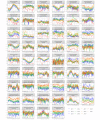Sustained Reductions in Online Search Interest for Communicable Eye and Other Conditions During the COVID-19 Pandemic: Infodemiology Study
- PMID: 35320981
- PMCID: PMC8931841
- DOI: 10.2196/31732
Sustained Reductions in Online Search Interest for Communicable Eye and Other Conditions During the COVID-19 Pandemic: Infodemiology Study
Abstract
Background: In a prior study at the start of the pandemic, we reported reduced numbers of Google searches for the term "conjunctivitis" in the United States in March and April 2020 compared with prior years. As one explanation, we conjectured that reduced information-seeking may have resulted from social distancing reducing contagious conjunctivitis cases. Here, after 1 year of continued implementation of social distancing, we asked if there have been persistent reductions in searches for "conjunctivitis," and similarly for other communicable disease terms, compared to control terms.
Objective: The aim of this study was to determine if reduction in searches in the United States for terms related to conjunctivitis and other common communicable diseases occurred in the spring-winter season of the COVID-19 pandemic, and to compare this outcome to searches for terms representing noncommunicable conditions, COVID-19, and to seasonality.
Methods: Weekly relative search frequency volume data from Google Trends for 68 search terms in English for the United States were obtained for the weeks of March 2011 through February 2021. Terms were classified a priori as 16 terms related to COVID-19, 29 terms representing communicable conditions, and 23 terms representing control noncommunicable conditions. To reduce bias, all analyses were performed while masked to term names, classifications, and locations. To test for the significance of changes during the pandemic, we detrended and compared postpandemic values to those expected based on prepandemic trends, per season, computing one- and two-sided P values. We then compared these P values between term groups using Wilcoxon rank-sum and Fisher exact tests to assess if non-COVID-19 terms representing communicable diseases were more likely to show significant reductions in searches in 2020-2021 than terms not representing such diseases. We also assessed any relationship between a term's seasonality and a reduced search trend for the term in 2020-2021 seasons. P values were subjected to false discovery rate correction prior to reporting. Data were then unmasked.
Results: Terms representing conjunctivitis and other communicable conditions showed a sustained reduced search trend in the first 4 seasons of the 2020-2021 COVID-19 pandemic compared to prior years. In comparison, the search for noncommunicable condition terms was significantly less reduced (Wilcoxon and Fisher exact tests, P<.001; summer, autumn, winter). A significant correlation was also found between reduced search for a term in 2020-2021 and seasonality of that term (Theil-Sen, P<.001; summer, autumn, winter). Searches for COVID-19-related conditions were significantly elevated compared to those in prior years, and searches for influenza-related terms were significantly lower than those for prior years in winter 2020-2021 (P<.001).
Conclusions: We demonstrate the low-cost and unbiased use of online search data to study how a wide range of conditions may be affected by large-scale interventions or events such as social distancing during the COVID-19 pandemic. Our findings support emerging clinical evidence implicating social distancing and the COVID-19 pandemic in the reduction of communicable disease and on ocular conditions.
Keywords: COVID-19; Google Trends; communicable disease; conjunctivitis; influenza; infodemiology; information-seeking; ocular symptoms; online health information; pandemic; seasonality; social distancing; trend.
©Michael S Deiner, Gerami D Seitzman, Gurbani Kaur, Stephen D McLeod, James Chodosh, Thomas M Lietman, Travis C Porco. Originally published in JMIR Infodemiology (https://infodemiology.jmir.org), 16.03.2022.
Conflict of interest statement
Conflicts of Interest: TML, TCP, MSD, and SDM received National Institutes of Health-National Eye Institute (NIH-NEI) grant support through the University of California San Francisco (UCSF), and JC did as well through a subcontract from UCSF. The other authors declare no conflicts of interest.
Figures


References
-
- Eysenbach G. Infodemiology and infoveillance: framework for an emerging set of public health informatics methods to analyze search, communication and publication behavior on the Internet. J Med Internet Res. 2009 Mar 27;11(1):e11. doi: 10.2196/jmir.1157. https://www.jmir.org/2009/1/e11/ v11i1e11 - DOI - PMC - PubMed
-
- Mavragani A. Infodemiology and infoveillance: scoping review. J Med Internet Res. 2020 Apr 28;22(4):e16206. doi: 10.2196/16206. https://www.jmir.org/2020/4/e16206/ v22i4e16206 - DOI - PMC - PubMed
-
- E-collection 'Infodemiology and Infoveillance'. Journal of Medical Internet Research. [2021-08-10]. https://www.jmir.org/collection/view/69 .
-
- E-collection 'Infoveillance, Infodemiology, Digital Disease Surveillance, Infodemic Management'. JMIR Public Health and Surveillance. [2021-08-10]. https://publichealth.jmir.org/collection/view/304 .
-
- Deiner MS, Seitzman GD, McLeod SD, Chodosh J, Hwang DH, Lietman TM, Porco TC. Ocular signs of COVID-19 suggested by internet search term patterns worldwide. Ophthalmology. 2021 Jan;128(1):167–169. doi: 10.1016/j.ophtha.2020.06.026. http://europepmc.org/abstract/MED/32562704 S0161-6420(20)30569-8 - DOI - PMC - PubMed
Grants and funding
LinkOut - more resources
Full Text Sources
Research Materials
Miscellaneous

